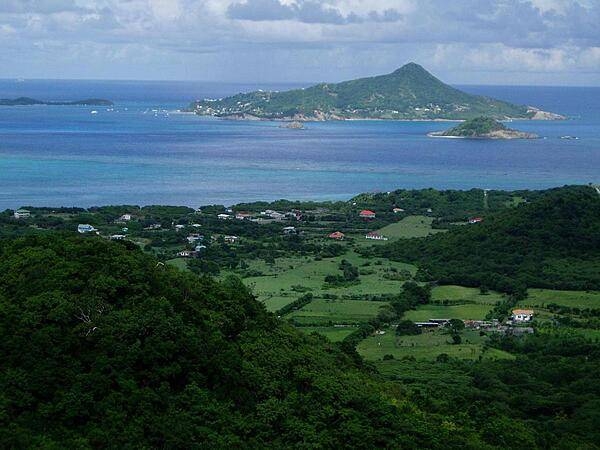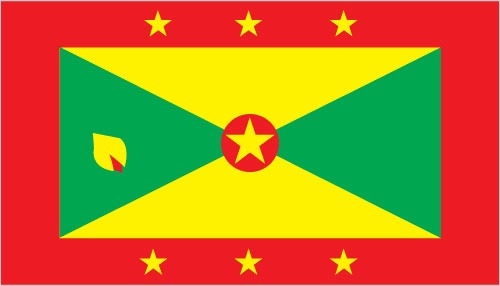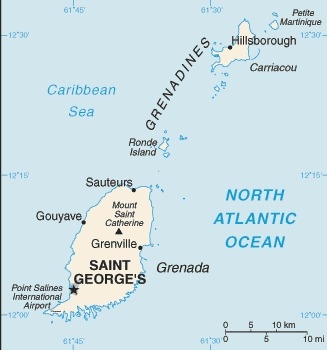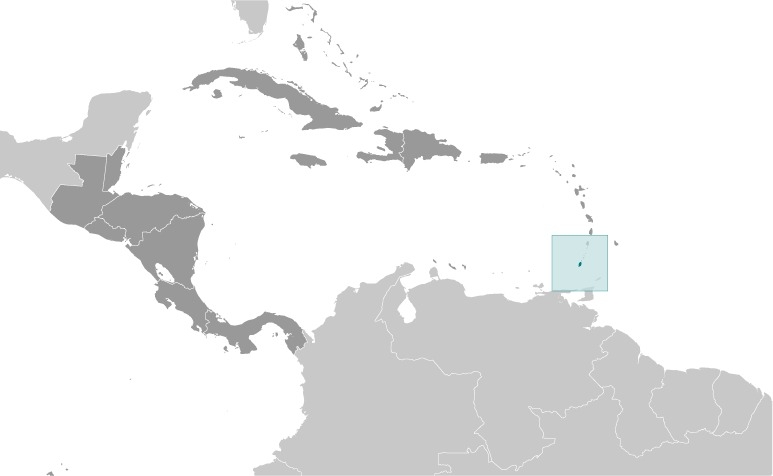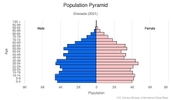Introduction
Background
Carib Indians inhabited Grenada when Christopher COLUMBUS discovered the island in 1498, but it remained uncolonized for more than a century. The French settled Grenada in the 17th century, established sugar estates, and imported large numbers of African slaves. Britain took the island in 1762 and vigorously expanded sugar production. In the 19th century, cacao eventually surpassed sugar as the main export crop; in the 20th century, nutmeg became the leading export. In 1967, Britain gave Grenada autonomy over its internal affairs. Full independence was attained in 1974 making Grenada one of the smallest independent countries in the Western Hemisphere. In 1979, a leftist New Jewel Movement seized power under Maurice BISHOP ushering in the Grenada Revolution. On 19 October 1983, factions within the revolutionary government overthrew and killed BISHOP and members of his party. Six days later the island was invaded by US forces and those of six other Caribbean nations, which quickly captured the ringleaders and their hundreds of Cuban advisers. The rule of law was restored and democratic elections were reinstituted the following year and have continued since then.
Visit the Definitions and Notes page to view a description of each topic.
Geography
Location
Caribbean, island between the Caribbean Sea and Atlantic Ocean, north of Trinidad and Tobago
Geographic coordinates
12 07 N, 61 40 W
Map references
Central America and the Caribbean
Land boundaries
total: 0 km
Coastline
121 km
Maritime claims
territorial sea: 12 nm
exclusive economic zone: 200 nm
Climate
tropical; tempered by northeast trade winds
Terrain
volcanic in origin with central mountains
Elevation
highest point: Mount Saint Catherine 840 m
lowest point: Caribbean Sea 0 m
Natural resources
timber, tropical fruit
Land use
agricultural land: 32.3% (2018 est.)
arable land: 8.8% (2018 est.)
permanent crops: 20.6% (2018 est.)
permanent pasture: 2.9% (2018 est.)
forest: 50% (2018 est.)
other: 17.7% (2018 est.)
Irrigated land
20 sq km (2012)
Population distribution
approximately one-third of the population is found in the capital of St. George's; the island's population is concentrated along the coast
Natural hazards
lies on edge of hurricane belt; hurricane season lasts from June to November
volcanism: Mount Saint Catherine (840 m) lies on the island of Grenada; Kick 'em Jenny, an active submarine volcano (seamount) on the Caribbean Sea floor, lies about 8 km north of the island of Grenada; these two volcanoes are at the southern end of the volcanic island arc of the Lesser Antilles that extends up to the Netherlands dependency of Saba in the north
Geography - note
the administration of the islands of the Grenadines group is divided between Saint Vincent and the Grenadines and Grenada
People and Society
Nationality
noun: Grenadian(s)
adjective: Grenadian
Ethnic groups
African descent 82.4%, mixed 13.3%, East Indian 2.2%, other 1.3%, unspecified 0.9% (2011 est.)
Languages
English (official), French patois
Religions
Protestant 49.2% (includes Pentecostal 17.2%, Seventh Day Adventist 13.2%, Anglican 8.5%, Baptist 3.2%, Church of God 2.4%, Evangelical 1.9%, Methodist 1.6%, other 1.2%), Roman Catholic 36%, Jehovah's Witness 1.2%, Rastafarian 1.2%, other 5.5%, none 5.7%, unspecified 1.3% (2011 est.)
Age structure
0-14 years: 23.23% (male 13,709/female 12,564)
15-24 years: 14.14% (male 8,034/female 7,959)
25-54 years: 40.05% (male 23,104/female 22,187)
55-64 years: 11.69% (male 6,734/female 6,490)
65 years and over: 10.89% (male 5,774/female 6,539) (2020 est.)
Dependency ratios
total dependency ratio: 50.5
youth dependency ratio: 35.8
elderly dependency ratio: 14.7
potential support ratio: 6.8 (2020 est.)
Median age
total: 33.3 years
male: 33.1 years
female: 33.4 years (2020 est.)
Population distribution
approximately one-third of the population is found in the capital of St. George's; the island's population is concentrated along the coast
Urbanization
urban population: 36.7% of total population (2021)
rate of urbanization: 0.86% annual rate of change (2020-25 est.)
Major urban areas - population
39,000 SAINT GEORGE'S (capital) (2018)
Sex ratio
at birth: 1.1 male(s)/female
0-14 years: 1.09 male(s)/female
15-24 years: 1.01 male(s)/female
25-54 years: 1.04 male(s)/female
55-64 years: 1.04 male(s)/female
65 years and over: 0.88 male(s)/female
total population: 1.03 male(s)/female (2020 est.)
Maternal mortality ratio
25 deaths/100,000 live births (2017 est.)
country comparison to the world: 122Infant mortality rate
total: 9.6 deaths/1,000 live births
male: 9.11 deaths/1,000 live births
female: 10.14 deaths/1,000 live births (2021 est.)
Life expectancy at birth
total population: 75.48 years
male: 72.86 years
female: 78.36 years (2021 est.)
Drinking water source
improved: total: 96.8% of population
unimproved: total: 3.2% of population (2017 est.)
Current Health Expenditure
4.5% (2018)
Physicians density
1.41 physicians/1,000 population (2017)
Hospital bed density
3.6 beds/1,000 population (2017)
Sanitation facility access
improved: total: 93.7% of population
unimproved: total: 6.3% of population (2017 est.)
HIV/AIDS - people living with HIV/AIDS
<500 (2018)
HIV/AIDS - deaths
<100 (2018)
Literacy
definition: age 15 and over can read and write
total population: 98.6%
male: 98.6%
female: 98.6% (2014 est.)
School life expectancy (primary to tertiary education)
total: 19 years
male: 18 years
female: 19 years (2018)
Environment
Environment - current issues
deforestation causing habitat destruction and species loss; coastal erosion and contamination; pollution and sedimentation; inadequate solid waste management
Environment - international agreements
party to: Biodiversity, Climate Change, Climate Change-Kyoto Protocol, Climate Change-Paris Agreement, Comprehensive Nuclear Test Ban, Desertification, Endangered Species, Law of the Sea, Ozone Layer Protection, Ship Pollution, Wetlands, Whaling
signed, but not ratified: none of the selected agreements
Air pollutants
particulate matter emissions: 21.56 micrograms per cubic meter (2016 est.)
carbon dioxide emissions: 0.27 megatons (2016 est.)
methane emissions: 2.04 megatons (2020 est.)
Climate
tropical; tempered by northeast trade winds
Land use
agricultural land: 32.3% (2018 est.)
arable land: 8.8% (2018 est.)
permanent crops: 20.6% (2018 est.)
permanent pasture: 2.9% (2018 est.)
forest: 50% (2018 est.)
other: 17.7% (2018 est.)
Urbanization
urban population: 36.7% of total population (2021)
rate of urbanization: 0.86% annual rate of change (2020-25 est.)
Revenue from forest resources
forest revenues: 0% of GDP (2018 est.)
country comparison to the world: 170Waste and recycling
municipal solid waste generated annually: 29,536 tons (2012 est.)
Total water withdrawal
municipal: 12 million cubic meters (2017 est.)
industrial: 0 cubic meters (2017 est.)
agricultural: 2.1 million cubic meters (2017 est.)
Total renewable water resources
200 million cubic meters (2017 est.)
Government
Country name
conventional long form: none
conventional short form: Grenada
etymology: derivation of the name remains obscure; some sources attribute the designation to Spanish influence (most likely named for the Spanish city of Granada), with subsequent French and English interpretations resulting in the present-day Grenada; in Spanish "granada" means "pomegranate"
Government type
parliamentary democracy under a constitutional monarchy; a Commonwealth realm
Capital
name: Saint George's
geographic coordinates: 12 03 N, 61 45 W
time difference: UTC-4 (1 hour ahead of Washington, DC, during Standard Time)
etymology: the 1763 Treaty of Paris transferred possession of Grenada from France to Great Britain; the new administration renamed Ville de Fort Royal (Fort Royal Town) to Saint George's Town, after the patron saint of England; eventually the name became simply Saint George's
Administrative divisions
6 parishes and 1 dependency*; Carriacou and Petite Martinique*, Saint Andrew, Saint David, Saint George, Saint John, Saint Mark, Saint Patrick
Independence
7 February 1974 (from the UK)
National holiday
Independence Day, 7 February (1974)
Constitution
history: previous 1967; latest presented 19 December 1973, effective 7 February 1974, suspended 1979 following a revolution but restored in 1983
amendments: proposed by either house of Parliament; passage requires two-thirds majority vote by the membership in both houses and assent of the governor general; passage of amendments to constitutional sections, such as personal rights and freedoms, the structure, authorities, and procedures of the branches of government, the delimitation of electoral constituencies, or the procedure for amending the constitution, also requires two-thirds majority approval in a referendum; amended 1991, 1992
Legal system
common law based on English model
International law organization participation
has not submitted an ICJ jurisdiction declaration; accepts ICCt jurisdiction
Citizenship
citizenship by birth: yes
citizenship by descent only: yes
dual citizenship recognized: yes
residency requirement for naturalization: 7 years for persons from a non-Caribbean state and 4 years for a person from a Caribbean state
Suffrage
18 years of age; universal
Executive branch
chief of state: Queen ELIZABETH II (since 6 February 1952); represented by Governor General Cecile LA GRENADE (since 7 May 2013)
head of government: Prime Minister Keith MITCHELL (since 20 February 2013)
cabinet: Cabinet appointed by the governor general on the advice of the prime minister
elections/appointments: the monarchy is hereditary; governor general appointed by the monarch; following legislative elections, the leader of the majority party or majority coalition usually appointed prime minister by the governor general
Legislative branch
description: bicameral Parliament consists of:
Senate (13 seats; members appointed by the governor general - 10 on the advice of the prime minister and 3 on the advice of the leader of the opposition party; members serve 5-year terms)
House of Representatives (15 seats; members directly elected in single-seat constituencies by simple majority vote to serve 5-year terms)
elections: Senate - last appointments on 27 April 2018 (next no later than2023)
House of Representatives - last held on 13 March 2018 (next no later than 2023)
election results: Senate - percent by party - NA; seats by party - NA; composition - men 11, women 2 percent of women 15.4%
House of Representatives - percent of vote by party - NNP 58.9%, NDC 40.5%; other 0.6% seats by party - NNP 15; composition - men 8, women 7, percent of women 46.7%; note - total Parliament percent of women 32.1%
Judicial branch
highest courts: regionally, the Eastern Caribbean Supreme Court (ECSC) is the superior court of the Organization of Eastern Caribbean States; the ECSC - headquartered on St. Lucia - consists of the Court of Appeal - headed by the chief justice and 4 judges - and the High Court with 18 judges; the Court of Appeal is itinerant, traveling to member states on a schedule to hear appeals from the High Court and subordinate courts; High Court judges reside in the member states, with 2 in Grenada; appeals beyond the ECSC in civil and criminal matters are heard by the Judicial Committee of the Privy Council (in London)
judge selection and term of office: chief justice of Eastern Caribbean Supreme Court appointed by Her Majesty, Queen ELIZABETH II; other justices and judges appointed by the Judicial and Legal Services Commission, and independent body of judicial officials; Court of Appeal justices appointed for life with mandatory retirement at age 65; High Court judges appointed for life with mandatory retirement at age 62
subordinate courts: magistrates' courts; Court of Magisterial Appeals
Political parties and leaders
National Democratic Congress or NDC [Nazim BURKE]
New National Party or NNP [Keith MITCHELL]
International organization participation
ACP, AOSIS, C, Caricom, CDB, CELAC, FAO, G-77, IBRD, ICAO, ICCt (signatory), ICRM, IDA, IFAD, IFC, IFRCS, ILO, IMF, IMO, Interpol, IOC, ITU, ITUC, LAES, MIGA, NAM, OAS, OECS, OPANAL, OPCW, Petrocaribe, UN, UNCTAD, UNESCO, UNIDO, UPU, WHO, WIPO, WTO
Diplomatic representation in the US
chief of mission: Ambassador Yolande Yvonne SMITH (since 8 April 2019)
chancery: 1701 New Hampshire Avenue NW, Washington, DC 20009
telephone: [1] (202) 265-2561
FAX: [1] (202) 265-2468
email address and website:
embassy@grenadaembassyusa.org
https://grenadaembassyusa.org/
consulate(s) general: Miami, New York
Diplomatic representation from the US
chief of mission: the US does not have an official embassy in Grenada; the US Ambassador to Barbados is accredited to Grenada
embassy: Lance-aux-Epines, Saint George's
mailing address: 3180 Grenada Place, Washington DC 20521-3180
telephone: [1] (473) 444-1173
FAX: [1] (473) 444-4820
email address and website:
StgeorgesACS@state.gov
https://bb.usembassy.gov/embassy/grenada/
Flag description
a rectangle divided diagonally into yellow triangles (top and bottom) and green triangles (hoist side and outer side), with a red border around the flag; there are seven yellow, five-pointed stars with three centered in the top red border, three centered in the bottom red border, and one on a red disk superimposed at the center of the flag; there is also a symbolic nutmeg pod on the hoist-side triangle (Grenada is a leading nutmeg producer); the seven stars stand for the seven administrative divisions, with the central star denoting the capital, St. George's; yellow represents the sun and the warmth of the people, green stands for vegetation and agriculture, and red symbolizes harmony, unity, and courage
National symbol(s)
Grenada dove, bougainvillea flower; national colors: red, yellow, green
National anthem
name: Hail Grenada
lyrics/music: Irva Merle BAPTISTE/Louis Arnold MASANTO
note: adopted 1974
Economy
Economic overview
Grenada relies on tourism and revenue generated by St. George’s University - a private university offering degrees in medicine, veterinary medicine, public health, the health sciences, nursing, arts and sciences, and business - as its main source of foreign exchange. In the past two years the country expanded its sources of revenue, including from selling passports under its citizenship by investment program. These projects produced a resurgence in the construction and manufacturing sectors of the economy.
In 2017, Grenada experienced its fifth consecutive year of growth and the government successfully marked the completion of its five-year structural adjustment program that included among other things austerity measures, increased tax revenue and debt restructuring. Public debt-to-GDP was reduced from 100% of GDP in 2013 to 71.8% in 2017.
Real GDP (purchasing power parity)
$1.7 billion note: data are in 2017 dollars (2020 est.)
$1.91 billion note: data are in 2017 dollars (2019 est.)
$1.87 billion note: data are in 2017 dollars (2018 est.)
note: data are in 2017 dollars
Real GDP growth rate
5.1% (2017 est.)
3.7% (2016 est.)
6.4% (2015 est.)
Real GDP per capita
$15,100 note: data are in 2017 dollars (2020 est.)
$17,100 note: data are in 2017 dollars (2019 est.)
$16,800 note: data are in 2017 dollars (2018 est.)
note: data are in 2017 dollars
GDP (official exchange rate)
$1.119 billion (2017 est.)
Credit ratings
Standard & Poors rating: SD (2013)
GDP - composition, by sector of origin
agriculture: 6.8% (2017 est.)
industry: 15.5% (2017 est.)
services: 77.7% (2017 est.)
GDP - composition, by end use
household consumption: 63% (2017 est.)
government consumption: 12% (2017 est.)
investment in fixed capital: 20% (2017 est.)
investment in inventories: -0.1% (2017 est.)
exports of goods and services: 60% (2017 est.)
imports of goods and services: -55% (2017 est.)
Agricultural products
bananas, watermelons, sweet potatoes, sugar cane, tomatoes, plantains, coconuts, melons, cucumbers, cabbages
Industries
food and beverages, textiles, light assembly operations, tourism, construction, education, call-center operations
Labor force - by occupation
agriculture: 11%
industry: 20%
services: 69% (2008 est.)
Population below poverty line
38% (2008 est.)
Household income or consumption by percentage share
lowest 10%: NA
highest 10%: NA
Budget
revenues: 288.4 million (2017 est.)
expenditures: 252.3 million (2017 est.)
Fiscal year
calendar year
Current account balance
-$77 million (2017 est.)
-$34 million (2016 est.)
Exports
$650 million note: data are in current year dollars (2018 est.)
$44.2 million (2016 est.)
Exports - partners
United States 40%, Saint Vincent and the Grenadines 7%, Saint Lucia 7%, France 6%, Netherlands 5%, Germany 5%, Ireland 5%, Antigua and Barbuda 5% (2019)
Exports - commodities
fish, nutmeg, cocoa beans, fruits, wheat, toilet paper (2019)
Imports
$640 million note: data are in current year dollars (2018 est.)
$314.7 million (2016 est.)
Imports - partners
United States 35%, Canada 24%, China 5% (2019)
Imports - commodities
aircraft, poultry meat, cars, refined petroleum, food preparation materials (2019)
Reserves of foreign exchange and gold
$199.1 million (31 December 2017 est.)
$198 million (31 December 2015 est.)
Debt - external
$793.5 million (2017 est.)
$682.3 million (2016 est.)
Exchange rates
East Caribbean dollars (XCD) per US dollar -
2.7 (2017 est.)
2.7 (2016 est.)
2.7 (2015 est.)
2.7 (2014 est.)
2.7 (2013 est.)
Energy
Electricity access
electrification - total population: 95.3% (2018)
Electricity - installed generating capacity
51,100 kW (2016 est.)
country comparison to the world: 190Electricity - from fossil fuels
96% of total installed capacity (2016 est.)
country comparison to the world: 39Electricity - from nuclear fuels
0% of total installed capacity (2017 est.)
country comparison to the world: 100Electricity - from hydroelectric plants
0% of total installed capacity (2017 est.)
country comparison to the world: 174Electricity - from other renewable sources
4% of total installed capacity (2017 est.)
country comparison to the world: 111Refined petroleum products - consumption
2,000 bbl/day (2016 est.)
country comparison to the world: 194Communications
Telephones - fixed lines
total subscriptions: 32,491 (2018)
subscriptions per 100 inhabitants: 29.3 (2018 est.)
Telephones - mobile cellular
total subscriptions: 113,177 (2018)
subscriptions per 100 inhabitants: 102.1 (2019 est.)
Telecommunication systems
general assessment: adequate, island-wide telephone system; lack of local competition, but telecoms are a high contributors to overall GDP; growth sectors include the mobile telephony and data segments (2020)
domestic: interisland VHF and UHF radiotelephone links; 29 per 100 for fixed-line and 102 per 100 for mobile-cellular (2019)
international: country code - 1-473; landing points for the ECFS, Southern Caribbean Fiber and CARCIP submarine cables with links to 13 Caribbean islands extending from the British Virgin Islands to Trinidad & Tobago including Puerto Rico and Barbados; SHF radiotelephone links to Trinidad and Tobago and Saint Vincent; VHF and UHF radio links to Trinidad (2019)
note: the COVID-19 pandemic continues to have a significant impact on production and supply chains globally; since 2020, some aspects of the telecom sector have experienced downturn, particularly in mobile device production; many network operators delayed upgrades to infrastructure; progress towards 5G implementation was postponed or slowed in some countries; consumer spending on telecom services and devices was affected by large-scale job losses and the consequent restriction on disposable incomes; the crucial nature of telecom services as a tool for work and school from home became evident, and received some support from governments
Broadcast media
multiple publicly and privately owned television and radio stations; Grenada Information Service (GIS) is government-owned and provides television and radio services; the Grenada Broadcasting Network, jointly owned by the government and the Caribbean Communications Network of Trinidad and Tobago, operates a TV station and 2 radio stations; Meaningful Television (MTV) broadcasts island-wide and is part of a locally-owned media house, Moving Target Company, that also includes an FM radio station and a weekly newspaper; multi-channel cable TV subscription service is provided by Columbus Communications Grenada (FLOW GRENADA) and is available island wide; approximately 25 private radio stations also broadcast throughout the country (2019)
Internet users
total: 66,600 (2021 est.)
percent of population: 59.07% (2019 est.)
Broadband - fixed subscriptions
total: 25,577 (2019)
subscriptions per 100 inhabitants: 22.84 (2019 est.)
Transportation
Airports - with paved runways
total: 3
2,438 to 3,047 m: 1
1,524 to 2,437 m: 1
under 914 m: 1 (2017)
Roadways
total: 1,127 km (2017)
paved: 902 km (2017)
unpaved: 225 km (2017)
Ports and terminals
major seaport(s): Saint George's
Military and Security
Military and security forces
no regular military forces; the Royal Grenada Police Force includes a Coast Guard and a paramilitary Special Services Unit
Military - note
Grenada joined the Caribbean Regional Security System (RSS) in 1985; RSS signatories (Antigua and Barbuda, Barbados, Dominica, Saint Kitts, Saint Lucia, and Saint Vincent and the Grenadines) agreed to prepare contingency plans and assist one another, on request, in national emergencies, prevention of smuggling, search and rescue, immigration control, fishery protection, customs and excise control, maritime policing duties, protection of off-shore installations, pollution control, national and other disasters, and threats to national security
Transnational Issues
Illicit drugs
a transit point for cocaine and marijuana destined for North America, Europe, and elsewhere in the Caribbean
